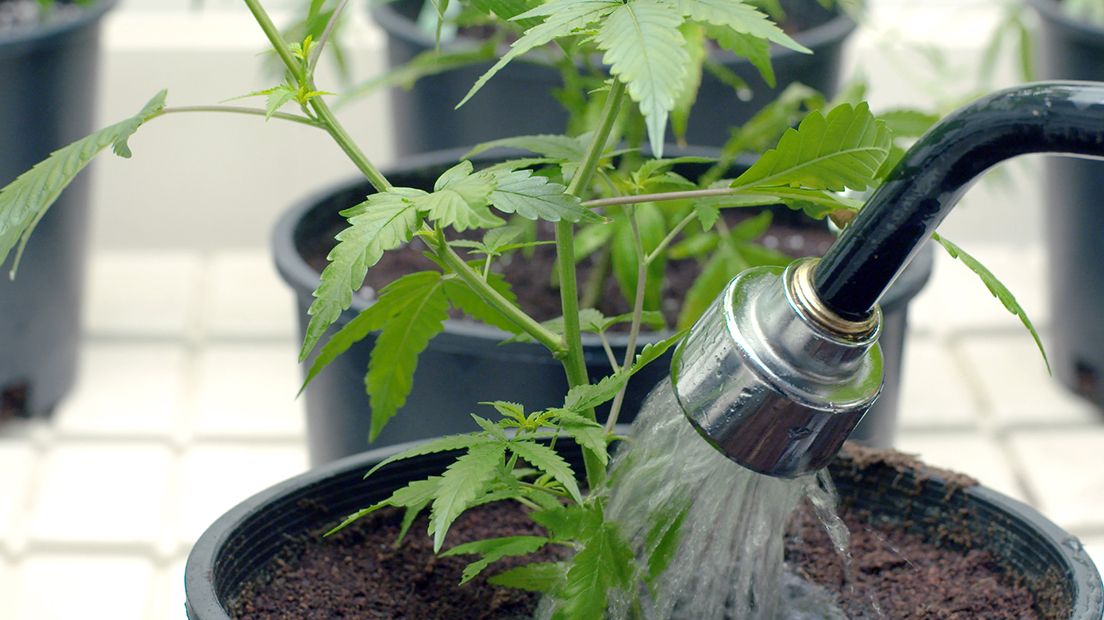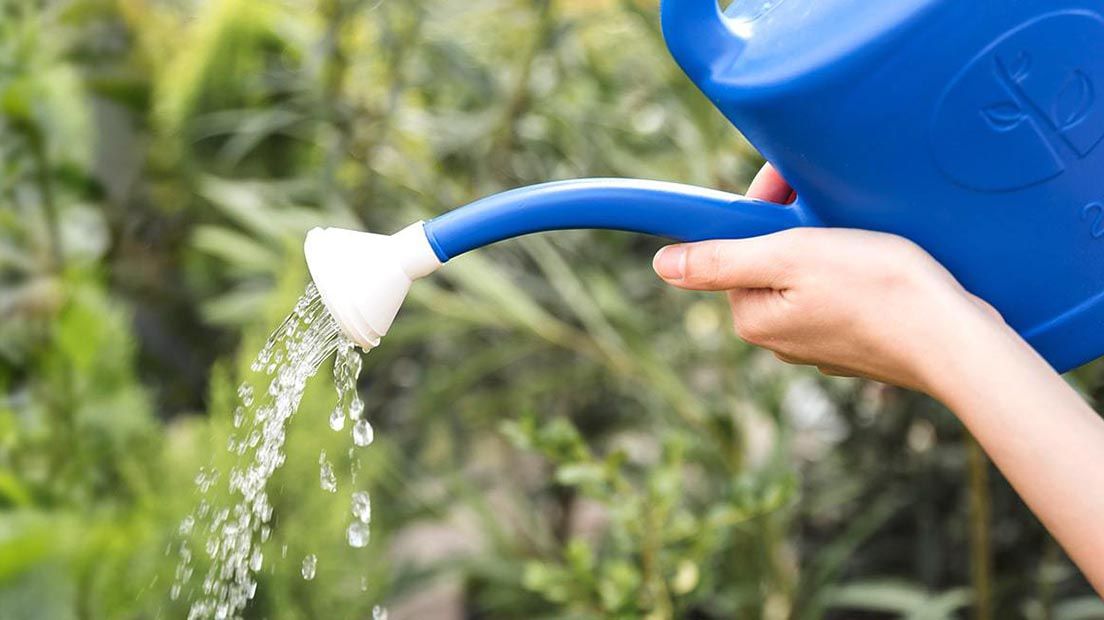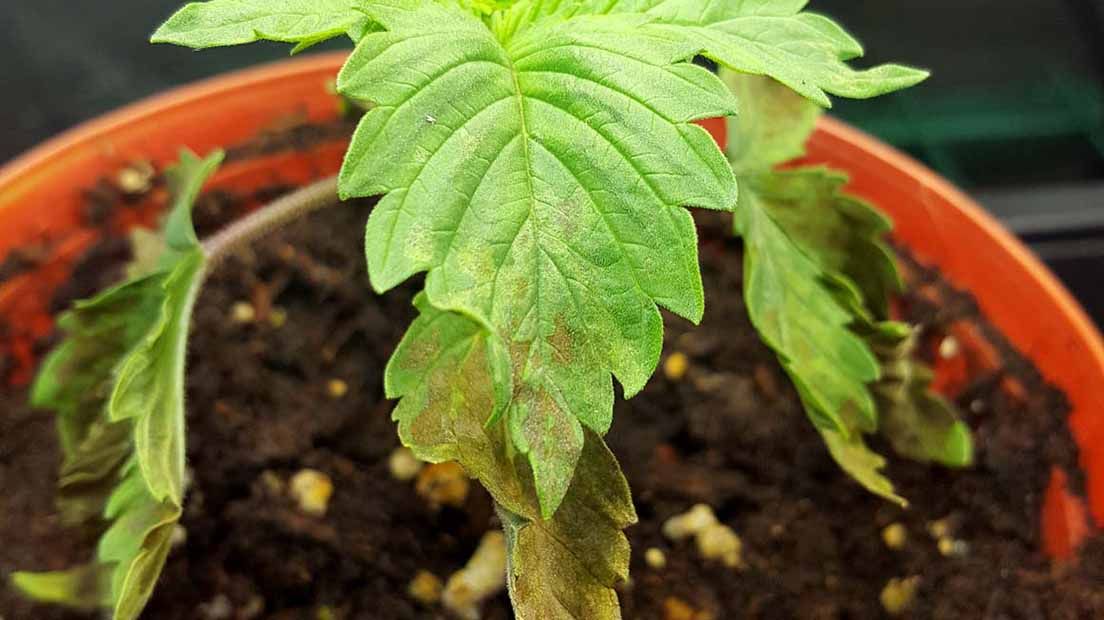How to Water Marijuana? The Watering Guide
Cannabis plants, regardless of the growing medium, need water to grow and offer us their delicious flowers. Water acts as a source of life and a vehicle for dissolved nutrients and minerals, which are absorbed through the roots and then spread to the rest of the plant. Watering marijuana is one of the most delicate tasks when growing plants, so today we bring you a complete guide on how to water marijuana.
Here you will find all the tricks for watering Cannabis properly and hassle free. In this article we will cover when to do it, how much water is needed, how to know when a plant needs watering and how to deal with over- and underwatering in marijuana growing. Remember as a general rule: Cannabis plants needs to alternate watering periods with dry periods.
How to water marijuana: The whole theory

All plants, including weed, are made up of approximately 80% water. It makes sense, therefore, that problems resulting from poor irrigation management can lead to crop failures. Outdoors, the plant usually finds the water it needs in the soil. However, this depends on the soil quality and its structure, but when Cannabis is grown indoors, it is very easy to over- or under-water. There is no general rule for watering marijuana, as this depends on many factors. Usually, though, when the soil is completely dry, it is time to water it.
Understanding how to water marijuana correctly can make a substantial difference to the quality and the quanty of the harvest and this guide explains how to identify, schedule and supply this vital ingredient to the plant.
The right water for Watering Weed

The quality of the water used to watering marijuana makes the difference in the final results. Ideally, the best water for watering Cannabis is the filtered one, other good options are demineralised or reverse osmosis water, as it is free of sediments and impurities. This is especially useful in regions where the water has a lot of lime.
Most growers use tap water, as in Spain there are many regions with high quality water and it is not necessary to filter it, specially in the North. However, there are many areas everywhere where the quality of the water is not the best, in these cases, an osmosis filter can improve the quality dramatically.
Regardless of the tap water we use to watering the plants, it often contains additional minerals. These depend on the location, but calcium, sodium and magnesium are the most common. The harder the water is, the lower the acidity, the higher the pH level and the higher the concentration of these minerals.
If filtered water is not used, it is best to test the water first. This means measuring its electroconductivity (EC) level and pH level or acidity. In terms of EC, tap water can be anywhere from 0.1 to 0.8 points, even higher.
If the water used to water the marijuana is very hard, i.e. has an EC greater than 0.2, it is recommended that it be diluted with pure water (EC = 0), such as rainwater or water filtered by the osmosis filter, until a lower EC is obtained. In order to evaporate the chlorine and other solids, it is also recommended leave the water for 24 hours in a bucket or bowl before use it.
When to Water the plants?

From the beginning of the crop a proper balance must be maintained when watering the plants , even before the seed has germinated into a seedling. When it comes to watering marijuana plants, there are a few factors that will determine how much and how often to water. These factors include the size of the plant and it’s pot, the roots development and also the grow room temperature and humidity and what stage of growth the plant is currently in. The best time to water your marijuana, as a rule, is in the morning.
Tips to Know When to Water Cannabis
One of the most effective tricks for watering marijuana, especially in soil and coco substrates, is taking two pots, the same ones we are growing with, fill them both with the same substrate, add water to one of them and leave the other dry. Afterwards, you can take them by hand and appreciate the difference in weight between one wet and the other dry. In this way, whenever you want to water, you can lift each pot and see whether you need to water or not. If the weight is close to that of the pot with the dry substrate, it is time to water.
The good rule of thumb is to wait until the soil is completelly dry and then water it, adjusting the amount of water to the size of the plant, so as not to drown it. However, it is necessary to water the marijuana in a way that is adapted to each phase of its life cycle, here are some examples for guidance.
As mentioned above, the morning is the best time to water your plants. This way, the plant has a whole day of sunlight and chemical processes for which it can use the water. Watering at night increases the chances that it will have to deal with fungus or mould.
Watering Seedlings
It is generally advisable to keep the seedlings and young shoots constantly hydrated, but not watering the substrate all the time, as this can create fungus. How can this be done? By spraying them with water frequently. This helps to ensure that the seedling has enough humidity and water, but not on the soil where we have to respect dry peirods to allow the plant to get oxigen, otherwise they will not be able to drink all the water and will die from lack of oxygen in the roots.
Watering Adult Plants
As the seedlings take root and grow, the soil can be allowed to dry out for short periods of time. These short dry periods will help limit the risks of fungal growth, which can make a plant sick and destroy it.
Just remember to water the plant when the substrate is dry, but don’t let the soil get too wet or dry, the time varies according to the climate but it usually settles down in 2 to 5 days. If you are growing in a different medium, such as coconut, you can water every day or once every 2 days, as it drains better. It is always advisable to use the trick of the weight of the pot to know if you want to water or not.
How much water should be watered?

The amount of water needed to water the marijuana can vary depending on many factors, the size of the plant, the temperature, the composition of the soil or substrate, the properties of the water you are using and the capacity of your air filtration systems, etc.
As a general rule, the maximum amount of water needed should be at least a quarter of the volume of the pot. We insist that this is a aproximate guideline but it depends on many factors.
Pot of 1L = 0.25L of water
4L = 1L of water
12L pot = 3 L of water
30L pot = 7.5 L of water
When the photoperiodic plants mature, it’s during the summer and the atmosphere becomes warmer and less humid. At this time the plants will need additional water. Larger plants generally need more water than smaller plants, with the exception of the final weeks of the flowering phase, when they consume less water and therefore need less watering.
As indicated, it is best to simply lift the pot to test its weight. If it seems light, most of the water is gone and therefore it is time to water the plants.
Regardless of the amount of water used for each watering, it is necessary to add it progressively. When you water too much at once, small channels will form in the soil. The water will drain quickly through these channels and will not be absorbed by the roots. Plants should always be watered slowly and evenly to ensure adequate hydration and distribution of nutrients.
Specific Watering Requirements According to Cannabis Variety
Understanding the specific watering needs for different cannabis strains is crucial to ensuring the maximum development and potential of each plant. Different strains have different water requirements, influenced by their genetic profiles, growth rates and environmental conditions. Let’s explore some popular strains and their specific watering needs.
Holy Punch
Holy Punch, a strain developed by Green House Seeds, is an excellent example of a potent and productive Indica plant. Due to its robust genetics, this strain can tolerate longer periods without water, compared to other more sensitive strains. However, this doesn’t mean neglecting watering, but rather adapting it to its ability to retain moisture in the soil. During the initial stages of growth, Holy Punch benefits from regular, moderate watering, which helps to establish a strong root system. As the plant develops, especially during the flowering phase, the frequency of watering can be gradually reduced, paying special attention to the weight of the soil and the humidity.
Auto Bomb
On the other hand, the Auto Bomb, with its complex genetic ancestry, including Bomb 1 and Ruderalis, exhibits a faster life cycle and, consequently, a different watering requirement. This autoflowering variety tends to require more frequent and consistent watering, especially during the first few weeks of life. Regularity is key to keeping Auto Bomb healthy, avoiding periods of drought that can stress the plant and affect its development. The use of a humidity meter can be particularly useful for this variety, ensuring that the amount of water supplied is adequate and constant throughout the plant’s life cycle.
Master Kush
The Master Kush, a renowned strain of Afghan origin, is known for its resistance and ability to thrive in diverse growing conditions. This Indica strain prefers less frequent but deeper waterings to encourage the growth of strong, deep roots. During the vegetation phase, Master Kush can benefit from a watering regime that allows the soil to partially dry out between waterings. This technique promotes good root aeration and prevents problems such as root rot. As it enters the flowering phase, the plant may need more water due to the increased flower production, but it is still important to avoid over-watering.
In addition to understanding the specific needs of each variety, it is important to consider factors such as soil type, climate and drainage capacity when planning a watering regime. Well-drained soil, rich in organic matter, generally retains moisture efficiently, reducing the need for frequent watering. Hotter, drier climates will require a different watering approach to cooler, wetter climates. Finally, careful monitoring of the plants and adapting to their responses to the watering regime are essential for successful cultivation.
Drainage in marijuana growing
When growing marijuana in pots, the water must be able to drain unobstructed from the bottom of the pot. This prevents the plant from becoming waterlogged and developing symptoms of overwatering. When you water your plants, make sure that the water is draining from the bottom. If this isn’t the case, the substrate may not be ideal; the best thing to do is to obtain a quality substrate.
What should you do with that drainage water? Although many pots have small trays to collect excess water, it is better to empty the water as soon as it starts to appear. Leaving the water to stand for long periods of time can lead to the appearance of bacteria that are harmful to the plants.
Problems Derived from Watering Marijuana
When the watering is not carried out correctly, the plant shows certain symptoms. The symptoms of an watering problem can appear on the leaves, stems or even on the roots. Often, a problem in the root system is the source of many other problems in the plant, such as withering and leaf fall.
The main symptoms we find on the leaves are: chlorosis, burnt tips, old leaves withering and curling down. Also, the leaves will grow slower and there will be areas with spots. The problems when watering the marijuana will mainly be on the older leaves, although young leaves can also be affected.
The plant’s stems will also be weakened and may bend slightly. Finally, the roots will have slow growing, brown in colour and will give off a bad smell. This is due to the fact that they have started to rot, favouring the appearance of unwanted mould and fungus.
What about over watering?

Overwatering is a serious and widespread error among beginners who are growing marijuana. They assume that something that is beneficial to marijuana like water can never be a bad thing, even if it is applied excessively. This is one of the most common mistakes, when you overwater the plants, the roots will start to drown.
This will cause the growth of the plant to slow down or even stop. Too much water can moisten the valuable air pockets where oxygen is stored, making less oxygen available for the roots to absorb. As a result, the roots will malfunction, lose their strength, and potentially fall victim to pathogens.
Overwatering is unlikely to occur when growing outdoors directly in soil, as the surrounding soil will absorb the excess water, but the problem can still occur, especially in areas with poor soil. Clay-based soils or soils that experience heavy rainfall do not favour water drainage, while sandy soils may drain too quickly. That’s why it’s important to know the characteristics of your soil and adjust your irrigation routine accordingly.
If the marijuana plants are in pots, it is easy to make the mistake of overwatering them. Without proper drainage, water will accumulate and drown the roots, which can lead to premature marijuana death. Even with proper drainage, the roots could receive too much water by watering the marijuana too often.
Because overwatering starts at the roots, you may not see any discoloration until a few days after overwatering. This is why watering problems are often detected late in the day and the solution is not so simple.
Solving Over watering
Overwatering is often caused by human error. Remember, unless you’re growing marijuana in a very dry environment, marijuana plants don’t need constant water and the dry/watering cycles must be respected.
Between waterings, check your soil’s hnumidity and make sure the substrate isn’t constantly wet. If it is, you should make adjustments in your watering routine. If you water too much, you should stop as soon as possible and give the plant as much time as it needs without watering until the roots recover. This can take days or even weeks in the most extreme cases. If the plant needs water, but as it is waterlogged its root system cannot get it, we can spray the plant on the leaves, but not water it in the ground. This seems to be an incongruity but it is very important, once the pot is waterlogged, the roots cannot absorb that water until they get oxygen first, and that oxygen can only be obtained when the soil in the pot is completely dry.
When using a drip irrigation system, the water flow or the distance of the pipes from the plant must be adjusted. Sometimes overwatering is caused by drainage problems. This could be due to the soil or the container. The marijuana soil should be thick and well aerated, so that excess water from watering the marijuana comes out.
If you have a drainage problem, it may be difficult to identify it. It is best to inspect everything. Perhaps the drainage holes are clogged. Maybe the soil has particles that are too small, which means they are closer together and don’t allow water to flow as easily.
Tips for watering marijuana

We must be very clear that by watering more, the plant does NOT drink more. The only thing you can do in this way is to stop the growth because the root has no oxygen, then the plant will start to turn yellow and finally it will die on its own or fall prey to the damned fungi. Marijuana is a rainfed plant that needs watering periods between rainfed periods, respect these cycles and your Cannabis plants will be happy.
Underwatering will also cause delays in correct growth, lower production, higher male count, damage to the plant and finally, if the dry period is too long, it will cause death by dehydration. So always water at the right point and give personalised attention, watering when each plant needs it, not all at once.
Also, to water the plants well and so that the plant does not suffer from shock, we should not use cold water, it is best to use water at a bit lower of the room temperature. It is also important that every time we water, we do so, as we have mentioned, in a progressive manner, adapting the size of the watering to the size of the plant.
In this way, during the first days of growth, we should water the marijuana in smaller doses and we should wait for the soil to dry out before watering again. Until the roots colonise the whole substrate, when we should always water the marijuana until it is soaked into the whole substrate and we should also wait for the whole pot to dry out before watering again.
It should also be noted that in the last weeks before harvesting, the Cannabis plants start to consume less water. At that time it is advisable to gradually reduce the amount of water we use to water the marijuana, as the soil will take longer to dry out again.
This also has two good parts, one is that it is the best way to prevent fungus like powdery mildew or botrytis, and the stress that less and less water puts on the plant promotes the formation of more resin.
In this way we must guarantee a healthy full watering cycle to the plants, when wet is the period of intake nutrients and when dry is the period of roots growth and oxygenation.
Summary for an hassle free watering:
- Marijuana is a rainfed plant that needs watering cycles.
- Each plant has its own needs.
- By watering more, the plant will not drink more.
- Water progressively.
- The more oxygen in the roots, the better for the plant.
- It doesn’t matter if the soil is dry at the top of the pot or wet at the bottom.
- The roots cannot drink water if there is no air.
- Plants can withstand a certain level of thirst.
Finally, remember that it is very important, besides watering the marijuana, to use specific fertilizers to feed the plants, the essential nutrients are a must to have strong specimens, while supplements are highly recommended to increase the production. It is also important to be aware constantly about the pH and the EC, as they have a decisive influence on the care of the Cannabis plants
We hope that this article will help you to know how to water your marijuana well. To continue reading we recommend you check out The Best 2020 Marijuana CBD enriched strains or our article about The Best Spanish Seed Banks, cheers!
Founder of Experiencia Natural, creative and entrepreneur, designer, master in grower and marketing. For a standardization of all plants and substances giving priority to patients and users.













